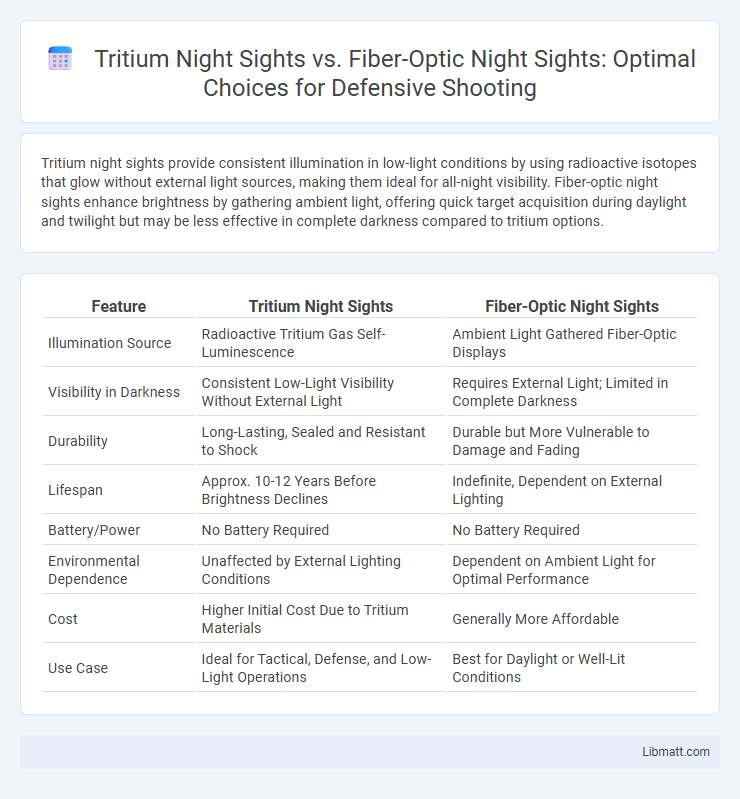Tritium night sights provide consistent illumination in low-light conditions by using radioactive isotopes that glow without external light sources, making them ideal for all-night visibility. Fiber-optic night sights enhance brightness by gathering ambient light, offering quick target acquisition during daylight and twilight but may be less effective in complete darkness compared to tritium options.
Table of Comparison
| Feature | Tritium Night Sights | Fiber-Optic Night Sights |
|---|---|---|
| Illumination Source | Radioactive Tritium Gas Self-Luminescence | Ambient Light Gathered Fiber-Optic Displays |
| Visibility in Darkness | Consistent Low-Light Visibility Without External Light | Requires External Light; Limited in Complete Darkness |
| Durability | Long-Lasting, Sealed and Resistant to Shock | Durable but More Vulnerable to Damage and Fading |
| Lifespan | Approx. 10-12 Years Before Brightness Declines | Indefinite, Dependent on External Lighting |
| Battery/Power | No Battery Required | No Battery Required |
| Environmental Dependence | Unaffected by External Lighting Conditions | Dependent on Ambient Light for Optimal Performance |
| Cost | Higher Initial Cost Due to Tritium Materials | Generally More Affordable |
| Use Case | Ideal for Tactical, Defense, and Low-Light Operations | Best for Daylight or Well-Lit Conditions |
Introduction to Night Sights
Night sights enhance firearm visibility in low-light conditions by using luminous technologies such as Tritium and fiber-optics. Tritium night sights employ radioactive gas to produce a continuous glow without external light exposure, ensuring reliable performance in complete darkness. Fiber-optic night sights gather ambient light and focus it into bright, colorful aiming points, offering rapid target acquisition in varying lighting environments.
What are Tritium Night Sights?
Tritium night sights use radioactive tritium gas to illuminate gun sights in low-light conditions, providing constant illumination without the need for external power. These self-luminous sights are highly durable and maintain brightness for up to 12 years, making them ideal for tactical and defensive use. Your firearm benefits from enhanced target acquisition in complete darkness, unlike fiber-optic sights that rely on ambient light for visibility.
What are Fiber-Optic Night Sights?
Fiber-optic night sights utilize brightly colored, light-gathering rods that channel ambient light to create a vivid aiming point, enhancing visibility in low-light conditions. These sights rely on external light sources rather than self-illumination, making them ideal for daytime and twilight shooting. Compared to tritium night sights, fiber-optic sights offer vibrant colors but may be less effective in complete darkness due to their dependence on ambient light.
Visibility in Low-Light Conditions
Tritium night sights provide consistent illumination in low-light conditions by emitting a self-powered glow that does not depend on ambient light, ensuring visibility in complete darkness. Fiber-optic night sights gather and amplify available light to enhance sight visibility but may dim in extremely low-light or no-light environments. Your choice between these sights should consider whether you prioritize reliable night visibility regardless of lighting or enhanced brightness in twilight and low-light scenarios.
Durability and Lifespan Comparison
Tritium night sights offer superior durability with a lifespan typically ranging from 10 to 12 years due to their self-luminous radioactive gas that requires no external light source. Fiber-optic night sights, while highly visible in daylight and enhance aiming precision, rely on ambient light to glow and generally last as long as the fiber optic rods remain intact, which can be affected by physical damage or environmental exposure. Your choice should prioritize Tritium for consistent nighttime performance and longer lifespan in rugged conditions.
Maintenance and Care Requirements
Tritium night sights require minimal maintenance due to their self-powered illumination, with no need for batteries or external light sources, ensuring consistent visibility in low-light conditions. Fiber-optic night sights rely on ambient light to enhance sight visibility, necessitating regular cleaning to remove dirt and grime that can obstruct the fiber and diminish brightness. Your choice may depend on how much time you're willing to spend on upkeep, as fiber-optic sights demand more frequent attention compared to the nearly maintenance-free tritium options.
Daytime vs Nighttime Performance
Tritium night sights provide superior nighttime performance due to their self-illuminating radioactive material that glows brightly in low-light conditions without requiring external light sources. Fiber-optic night sights excel in daytime visibility by capturing ambient light and displaying vibrant colors, but their glow fades significantly in darkness. For optimal all-day use, combining tritium's consistent night visibility with fiber-optic's bright daytime contrast offers the best overall sighting solution.
Cost and Value Analysis
Tritium night sights typically cost more upfront due to their radioactive gas tubes providing low-light illumination without external light sources, offering long-lasting visibility and durability. Fiber-optic night sights are generally more affordable, utilizing ambient light to brighten the fibers, but may lose effectiveness in complete darkness, impacting value for low-light shooting scenarios. You should consider how frequently and in what lighting conditions you shoot to determine which offers the best cost-to-performance ratio for your needs.
User Preferences and Applications
Tritium night sights provide consistent illumination in low-light conditions without requiring external light sources, making them the preferred choice for tactical and self-defense applications. Fiber-optic night sights rely on ambient light to gather and amplify visibility, appealing to outdoor shooters and sport shooters who operate in varying light environments. User preferences often hinge on the intended application, with Tritium favored for reliability in darkness and Fiber-optic chosen for brighter, daylight-enhanced sight picture.
Choosing the Right Night Sight for You
Tritium night sights provide consistent visibility in low-light conditions by emitting a steady glow without needing external light sources, making them ideal for nighttime use or low-light environments. Fiber-optic night sights gather ambient light to amplify the sight picture, enhancing brightness during the day but losing visibility in complete darkness. Understanding your typical shooting conditions and preferences will help you decide whether the long-lasting illumination of Tritium or the daylight brightness of fiber-optic sights best suits your firearm needs.
Tritium night sights vs Fiber-optic night sights Infographic

 libmatt.com
libmatt.com